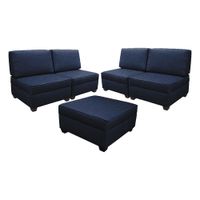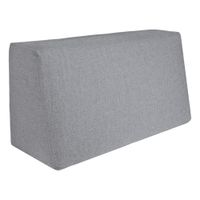Call +(254) 703 030 000 / 751 483 999 / 721 704 777
- Home
- Furnishings Appliances Hospitality
- Furniture
- Reception Lounge Furniture
- Modular Furniture
Frequently Asked Questions
What is modular furniture?
Modular furniture refers to a type of furniture that is designed with standardized units or sections, allowing for flexibility and customization in arrangement and use. These pieces can be easily assembled, disassembled, and reconfigured to suit different spaces and needs, making them highly versatile and adaptable.
Typically, modular furniture includes items like sofas, shelving units, desks, and storage systems that can be combined in various ways to create different configurations. For example, a modular sofa might consist of individual sections such as seats, armrests, and backrests that can be rearranged to form a traditional sofa, a sectional, or even separate seating areas.
The primary advantage of modular furniture is its adaptability. It allows users to modify their living or working spaces without the need to purchase new furniture. This is particularly beneficial in small or multifunctional spaces where flexibility is crucial. Additionally, modular furniture often features a modern, minimalist design, making it aesthetically appealing in contemporary settings.
Another benefit is ease of transport and installation. Since modular pieces are typically lightweight and can be broken down into smaller components, they are easier to move and set up compared to traditional furniture. This makes them ideal for people who relocate frequently or for businesses that need to reconfigure office layouts regularly.
In summary, modular furniture offers a practical and stylish solution for dynamic living and working environments, providing the flexibility to adapt to changing needs and preferences.
How does modular furniture maximize space?
Modular furniture maximizes space through its adaptable and customizable design, allowing it to fit various room sizes and configurations. It consists of individual pieces that can be rearranged, stacked, or expanded to suit specific needs, making it ideal for small or irregularly shaped spaces. By offering multifunctionality, such as a sofa that converts into a bed or a table with built-in storage, modular furniture reduces the need for multiple separate pieces, thus saving space.
The flexibility of modular furniture allows for easy reconfiguration, enabling users to optimize their living area as their needs change. For instance, a modular shelving unit can be adjusted to accommodate different items, or a modular desk can be expanded for additional workspace. This adaptability ensures that every inch of space is utilized efficiently.
Additionally, modular furniture often features a sleek, minimalist design, which contributes to a less cluttered appearance, making a room feel more spacious. Its components are typically lightweight and easy to move, facilitating quick rearrangements to open up space or create new layouts.
Furthermore, modular furniture can be tailored to fit specific dimensions, ensuring that no space is wasted. Customizable options allow users to select the size, shape, and configuration that best fits their room, maximizing both functionality and aesthetics.
In summary, modular furniture maximizes space by offering flexibility, multifunctionality, and customization, allowing for efficient use of available space while adapting to changing needs and preferences.
What are the benefits of modular multifunctional furniture?
Modular multifunctional furniture offers several benefits:
1. **Space Efficiency**: It maximizes the use of available space, making it ideal for small apartments or rooms. Pieces can be rearranged or expanded to fit different spaces and needs.
2. **Versatility**: These pieces can serve multiple purposes, such as a sofa that converts into a bed or a table that doubles as storage. This adaptability allows for a dynamic living environment.
3. **Cost-Effective**: By combining multiple functions into one piece, it reduces the need to purchase separate items, saving money in the long run.
4. **Customization**: Modular furniture can be tailored to individual preferences and needs. Users can add or remove modules to create a personalized setup.
5. **Ease of Movement**: Lightweight and often designed for easy assembly and disassembly, modular furniture is convenient for people who move frequently.
6. **Aesthetic Appeal**: It often features modern, sleek designs that can enhance the visual appeal of a space. The ability to reconfigure pieces also allows for fresh looks without additional costs.
7. **Sustainability**: By reducing the need for multiple pieces of furniture, it minimizes material use and waste. Many modular systems are also designed with sustainable materials.
8. **Functionality**: It supports a variety of activities and lifestyles, accommodating work, relaxation, and entertainment within the same space.
9. **Innovation**: Encourages creative use of space and can incorporate technology, such as built-in charging stations or smart features.
10. **Social Interaction**: Facilitates social gatherings by allowing for easy reconfiguration to accommodate more people or different activities.
Overall, modular multifunctional furniture provides practical, economic, and aesthetic advantages, making it a popular choice for modern living.
How can modular furniture be reconfigured for different spaces?
Modular furniture is designed to be versatile and adaptable, allowing it to be reconfigured to suit various spaces and needs. Here’s how it can be reconfigured:
1. **Interchangeable Components**: Modular furniture often consists of interchangeable parts that can be rearranged. For example, modular sofas can have sections added or removed to fit different room sizes or layouts.
2. **Stackable Units**: Many modular pieces are stackable, allowing for vertical reconfiguration. This is useful in small spaces where maximizing floor space is essential.
3. **Adjustable Dimensions**: Some modular furniture includes adjustable features, such as extendable tables or height-adjustable desks, which can be modified to fit different spaces or purposes.
4. **Multi-functional Pieces**: Modular furniture often serves multiple functions. A modular shelving unit can be reconfigured to act as a room divider, storage, or display unit, depending on the space requirements.
5. **Easy Assembly and Disassembly**: The design of modular furniture typically allows for easy assembly and disassembly, making it simple to move and reconfigure as needed.
6. **Customizable Layouts**: Users can create custom layouts by combining different modules. For instance, modular office furniture can be arranged to create individual workstations or collaborative spaces.
7. **Adaptable Aesthetics**: Modular furniture often comes with interchangeable covers or finishes, allowing it to adapt to different decor styles or color schemes.
8. **Space Optimization**: By reconfiguring modular furniture, users can optimize space usage, such as converting a living room into a guest bedroom with a modular sofa bed.
9. **Scalability**: As needs change, additional modules can be added to expand the furniture’s functionality, making it suitable for growing families or evolving office environments.
These features make modular furniture an ideal choice for dynamic spaces that require frequent reconfiguration.
What materials are used in modular furniture cushions?
Modular furniture cushions are crafted from a variety of materials to ensure comfort, durability, and aesthetic appeal. The core of these cushions often consists of high-density foam, which provides support and maintains shape over time. Memory foam is also popular for its ability to conform to the body, offering personalized comfort.
For added softness, cushions may include a layer of polyester fiberfill or down feathers. Polyester fiberfill is a synthetic material that is hypoallergenic and provides a plush feel. Down feathers, sourced from ducks or geese, offer a luxurious softness but may require regular fluffing to maintain their loft.
The cushion covers are typically made from durable fabrics such as cotton, polyester, or blends of both. These materials are chosen for their resistance to wear and ease of cleaning. For outdoor modular furniture, covers are often made from weather-resistant materials like acrylic or olefin, which resist fading and moisture.
Some cushions incorporate gel-infused foam or cooling gel layers to regulate temperature, enhancing comfort in warmer climates. Additionally, latex foam is sometimes used for its natural resilience and hypoallergenic properties.
In sustainable designs, cushions may feature eco-friendly materials such as organic cotton covers or natural latex foam. Recycled polyester is also used in some cushions to reduce environmental impact.
Overall, the choice of materials in modular furniture cushions balances comfort, durability, and style, catering to diverse consumer preferences and needs.
How do you replace worn modular couch cushions?
To replace worn modular couch cushions, follow these steps:
1. **Measure the Cushions**: Remove the worn cushions and measure their dimensions (length, width, and thickness) to ensure the new ones fit perfectly.
2. **Select Replacement Cushions**: Choose cushions made from durable materials like high-density foam or memory foam for longevity and comfort. Consider the cushion's firmness based on your preference.
3. **Choose Fabric Covers**: Select fabric covers that match your couch and decor. Opt for durable, easy-to-clean materials like microfiber, cotton, or leather.
4. **Purchase or Order**: Buy pre-made cushions and covers from furniture stores or order custom ones online. Ensure they match the measurements and style of your couch.
5. **Remove Old Cushions**: Take off the old cushion covers and dispose of the worn foam or padding. If the covers are still in good condition, you might reuse them.
6. **Insert New Foam**: Place the new foam into the cushion covers. Ensure the foam fits snugly without any gaps or bulges.
7. **Secure the Covers**: Zip or fasten the covers securely around the new foam. Smooth out any wrinkles or uneven areas.
8. **Arrange on Couch**: Place the new cushions on the couch, ensuring they align properly with the modular sections.
9. **Test for Comfort**: Sit on the couch to test the comfort and adjust the cushions if necessary.
10. **Maintain Regularly**: Rotate and fluff the cushions regularly to maintain their shape and comfort. Clean the covers as per the manufacturer's instructions to prolong their life.
By following these steps, you can effectively replace worn modular couch cushions, enhancing both the comfort and appearance of your furniture.
Can modular furniture be used in both residential and commercial spaces?
Yes, modular furniture can be used in both residential and commercial spaces due to its versatility, adaptability, and functionality.
In residential spaces, modular furniture offers flexibility to accommodate various room sizes and layouts. It allows homeowners to customize their living spaces according to their needs and preferences. For instance, modular sofas can be rearranged to fit different room configurations, while modular shelving units can be adjusted to store a variety of items, from books to decorative pieces. This adaptability is particularly beneficial in smaller homes or apartments where space optimization is crucial.
In commercial spaces, modular furniture is equally advantageous. Offices, for example, benefit from modular workstations that can be reconfigured to support different team sizes and work styles. This flexibility is essential in dynamic work environments where collaboration and privacy needs may change frequently. Additionally, modular conference tables and seating can be adjusted to accommodate different meeting sizes and purposes. Retail spaces also utilize modular displays and shelving to easily update store layouts and product presentations.
Overall, the key benefits of modular furniture in both settings include cost-effectiveness, as it reduces the need for frequent replacements; ease of assembly and disassembly, which facilitates relocation and reconfiguration; and sustainability, as it often involves fewer materials and can be repurposed or expanded over time. These attributes make modular furniture a practical choice for a wide range of applications in both residential and commercial environments.

